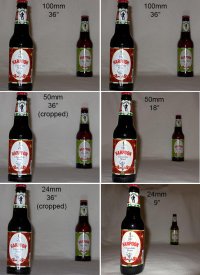Here's an example from the wiki page on
perspective distortion, an example that illustrates some of this confusion:
You see the different focal lengths printed on the images, and you see the relative sizes of the two water bottles changing, and you think that focal length is the reason. Even the text in the caption of that image suggests the effect is due to focal length. But consider...the pink bottle is the same height in all three images - therefore, as the focal length is reduced, the camera must have been moved closer to achieve the same framing. It's the movement of the camera, not the change in focal length, that results in the different perspectives.
Let me try to illustrate what I mean with a similar set of examples, but where I first vary just focal length but not distance, and then vary focal length and distance. Since I prefer beverages other than water, I selected a different pair of subjects for a similar test.
The two bottles are 18" apart, and the distances in the image below are measured from the sensor to the front bottle. All were shot at f/5.6. As described above, it's normal for the bottle in front to look larger, that's perspective - objects that are further away look smaller, even though we know they are the same size. Note that the bottle in front is the same height in all the images.
In the left column, the 50mm and 24mm shots were at the same distance as the 100mm images, and the images were cropped to match the framing of the 100mm image. As you can see, the relative size of the rear bottle is the same in all the images. The perspective is the same - the two bottles maintain the same relative size, despite the differing focal lengths. The distance is the same, so the perspective is the same.
In the right column, which is equivalent to the water bottle shots from the wiki page, the 50mm and 24mm shots were taken at successively closer distances to the bottles, matching the framing to the 100mm shot by moving the camera. As you can see, the relative size of the rear bottle gets smaller as the camera is moved closer. Different perspective, because the distance is changing. Comparing the side-by-side 50mm and 24mm images, you can see that with the same focal length but different subject distances, the perspective is different.
So, varying focal length alone, without changing distance, does not affect perspective. As stated above (by me and others), perspective is determined by distance, and distance alone.
As others pointed out above, 'telephoto' compression and 'wide angle' expansion distortion are the same phenomenon. The reference to 'telephoto' and 'wide angle' there is misleading - it has nothing to do with the focal lengths, only the distance. But longer lenses are usually used at longer distances, and wide lenses are usually used at closer distances (think of framing a person for a portrait), thus the erroneous association with a lens type when it's really the commonly used distances for those lenses that is the cause of both types of perspective distortion.
Regardless of whether or not this clarifies what determines perspective, I'm about to enjoy that bottle of Chocolate Stout. ;D


